Optimization of Microbial Consortia for Enhanced Biodegradation of Environmental Pollutants
Received: 03-Mar-2025 / Manuscript No. jbrbd-25-164621 / Editor assigned: 03-Mar-2025 / PreQC No. jbrbd-25-164621 (PQ) / Reviewed: 19-Mar-2025 / QC No. jbrbd-25-164621 / Revised: 24-Mar-2025 / Manuscript No. jbrbd-25-164621 (R) / Accepted Date: 30-Mar-2025 / Published Date: 30-Mar-2025
Abstract
The optimization of microbial consortia has emerged as a promising approach for the enhanced biodegradation of environmental pollutants. Microbial consortia, composed of diverse microorganisms, exhibit synergistic interactions that can break down a wide range of organic and inorganic contaminants. This study explores the optimization of microbial consortia for efficient bioremediation of environmental pollutants, focusing on parameters such as microbial composition, nutrient supplementation, environmental conditions, and incubation time. By improving the microbial interactions and conditions, we aim to enhance the biodegradation rates and the overall efficiency of pollutant removal. The findings demonstrate the potential of optimized microbial consortia in treating complex contaminants in soil and water systems, offering an environmentally sustainable alternative to traditional chemical-based remediation methods.
Keywords
Microbial consortia; Biodegradation; Environmental pollutants; Synergistic interactions; Microbial optimization; Pollutant removal; Soil and water treatment
Introduction
The increasing levels of environmental pollution, particularly in soil and water systems, have raised concerns regarding ecosystem health and human safety. Contaminants such as heavy metals, pesticides, industrial effluents, and hydrocarbons pose significant threats to the environment, making their efficient removal a crucial aspect of environmental protection [1]. Traditional remediation methods, while effective, often involve high costs and the use of hazardous chemicals. In contrast, bioremediation, which utilizes microorganisms to degrade pollutants, offers a cost-effective and environmentally friendly alternative. Microbial consortia, a group of diverse microorganisms, have gained attention for their ability to degrade pollutants through synergistic interactions. These consortia can outperform individual species by breaking down complex contaminants that a single microorganism may not be able to degrade effectively [2]. However, the efficiency of microbial consortia in bioremediation can be influenced by various factors, such as microbial diversity, nutrient availability, environmental conditions, and metabolic pathways. Optimizing microbial consortia for pollutant degradation requires a deep understanding of microbial interactions, nutrient dynamics, and environmental conditions. By manipulating these factors, it is possible to enhance the biodegradation efficiency of consortia and improve the overall process of bioremediation [3]. This research aims to explore strategies for optimizing microbial consortia to maximize their potential in the biodegradation of environmental pollutants, focusing on enhancing pollutant removal rates and sustainability in real-world applications.
Methodology
Selection of Pollutants: The study focused on a variety of environmental pollutants, including hydrocarbons (e.g., petroleum and diesel), heavy metals (e.g., cadmium, lead), and agricultural pesticides [4]. These pollutants were selected due to their widespread presence in contaminated environments and their harmful effects on ecosystems.
Microbial consortium isolation: Microbial consortia were isolated from polluted soil and water samples collected from various contaminated sites. The samples were serially diluted and plated on selective media to identify potential pollutant-degrading microorganisms [5]. A range of bacteria, fungi, and yeast species with biodegradation capabilities were identified.
Optimization of microbial composition: Different combinations of microorganisms were tested to assess their synergistic effects on pollutant degradation. The consortia were selected based on their ability to degrade specific pollutants, and the best-performing microbial strains were included in the consortium [6]. Co-culture experiments were conducted to evaluate the interactions between different microorganisms.
Optimization of environmental conditions: The biodegradation process was optimized by adjusting factors such as temperature, pH, salinity, oxygen levels, and nutrient availability. A series of batch experiments were conducted under controlled laboratory conditions to determine the optimal conditions for microbial growth and pollutant degradation. Different carbon and nitrogen sources were tested to support the microbial growth and enhance biodegradation [7]. The effects of organic and inorganic nutrient amendments on the activity and efficiency of the microbial consortia were also evaluated.
Biodegradation assessment: The biodegradation efficiency was measured by monitoring the reduction in pollutant concentrations over time. Various analytical techniques, including gas chromatography-mass spectrometry (GC-MS) for hydrocarbon analysis, atomic absorption spectrophotometry (AAS) for heavy metal detection, and high-performance liquid chromatography (HPLC) for pesticide quantification, were used to assess the pollutant removal rate [8,9].
Data analysis: Statistical analysis was performed to identify the significant factors influencing microbial consortia optimization. Regression analysis and response surface methodology (RSM) were applied to model the relationship between the independent variables (microbial composition, environmental conditions, nutrient levels) and the biodegradation efficiency [10].
Conclusion
This study demonstrates the potential of optimizing microbial consortia for the enhanced biodegradation of environmental pollutants. The results indicate that microbial consortia, when carefully selected and optimized for environmental conditions, can significantly improve the efficiency of pollutant removal. Synergistic interactions between microbial species were found to be crucial for breaking down complex contaminants that individual microorganisms could not degrade effectively. Additionally, optimizing environmental factors such as temperature, pH, and nutrient availability further enhanced the biodegradation rates. The findings suggest that microbial consortia have the potential to be a sustainable and cost-effective solution for bioremediation of polluted environments. By tailoring microbial composition and optimizing environmental conditions, it is possible to maximize the biodegradation potential of microbial consortia. This approach could provide an alternative to traditional chemical-based remediation methods, offering an eco-friendly solution to environmental pollution. Further research is needed to investigate the scalability of these optimized consortia in field conditions and to explore their long-term sustainability in diverse environmental settings.
Acknowledgement
None
Conflict of Interest
None
Citation: Gurley F (2025) Optimization of Microbial Consortia for EnhancedBiodegradation of Environmental Pollutants. J Bioremediat Biodegrad, 16: 669.
Copyright: © 2025 Gurley F. This is an open-access article distributed under theterms of the Creative Commons Attribution License, which permits unrestricteduse, distribution, and reproduction in any medium, provided the original author andsource are credited.
Select your language of interest to view the total content in your interested language
Share This Article
Recommended Journals
Open Access Journals
Article Usage
- Total views: 316
- [From(publication date): 0-0 - Dec 12, 2025]
- Breakdown by view type
- HTML page views: 247
- PDF downloads: 69
